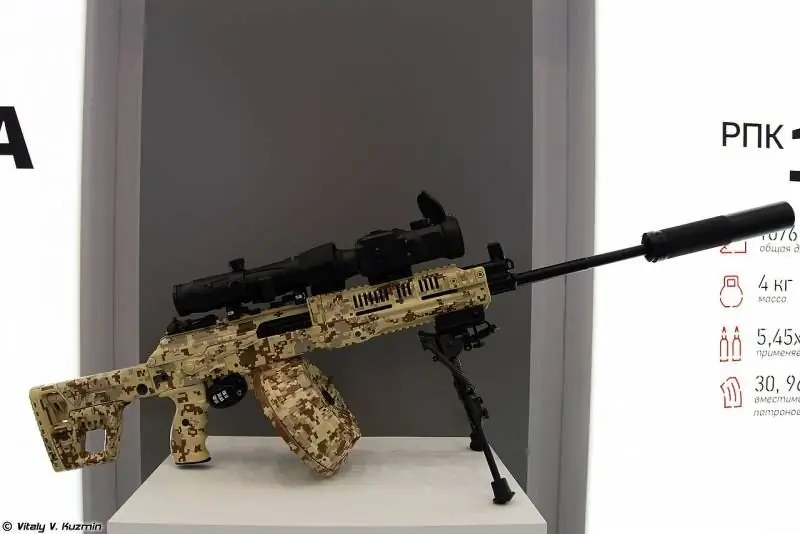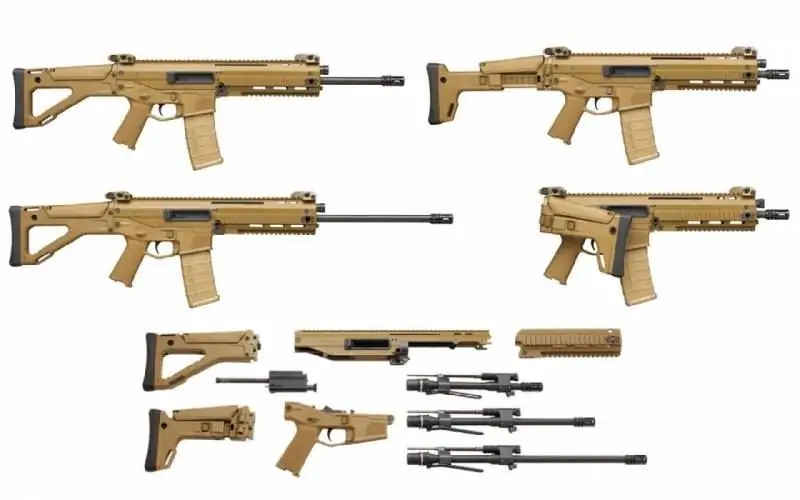- Author Matthew Elmers [email protected].
- Public 2023-12-16 21:49.
- Last modified 2025-01-24 09:17.
The reason for writing this material was the recently published VO article "Why modular weapons are evil."

To form a more complete picture, I decided to supplement the topic with arguments in favor of modular weapons.
The place of modular weapons in modern aircraft
Modern warfare is becoming more and more technological - this inevitably affects the requirements for the level of training of both the rank and file and the command.
The low effectiveness of the "urgent draft" has long been evident. What can you teach a person in two years, and even more so in one?
The next logical step was the creation of the MTR (Special Operations Forces) - professionally trained high-level military personnel.
The high level of training allows you to use a much larger arsenal of tactics.
The set of available tactics directly depends both on the equipment of the fighters and on their training. A unit cannot effectively use mines if the fighters are not trained to do so. The commander cannot plan an attack at night, taking advantage of the fact that his fighters have a night vision device if they do not have a night vision device.
One is interconnected with the other - knowledge, skills, equipment.
Therefore, equipment flexibility is a very important issue for the MTR.
Why do you need different weapons?
Let me give you a simple example. For a long time, the United States fought in Iraq. And most of the operations with fire contacts took place in urban (by Iraqi standards) development.
At the same time, in Afghanistan, the militants at some point realized that using 7, 62 calibers against the United States, they were able to more confidently hit their targets. While the forces of the "coalition" were forced to shoot with a smaller caliber.
In mountainous conditions (where there are significant changes in altitude and temperature), the direction and strength of the wind changes in large ranges, so a heavier ammunition will always be more preferable.
In view of this, it is impossible to create one machine gun for the entire army, which at the same time will show high efficiency in all situations. Therefore, we will not be able to get away from creating weapons in different calibers and with different barrels.
The only question is whether it will be a modular option or not.
Tactical demonstration
To demonstrate how it all looks in practice, imagine that you are in command of a platoon, which consists of three squads of eight each.

You are based at Outpost Charlie and there is a small village 20 km away. In addition to you, there are other personnel at the base, but one of your departments must participate in the protection of the base.
To increase your firepower, you arm the squad participating in the protection with 4 machine guns.
Then an order comes - to patrol the road on a section of 10 km. This task is assigned to the 2nd department. The third - remains at the base in a state of BG (combat readiness).
There is also a report that a week ago a patrol was ambushed in a neighboring area, and fire was fired from several SVDs, among other things.
You decide to arm the patrol squad with a large number of long-range rifles - instead of 1 infantry sniper becomes 3.
Two days later, you are ordered to search houses in a nearby village. The two squads provide cover while staying outside. And a subunit equipped with weapons with short barrels, more convenient for indoor combat, enters the village itself. Including with 2 light light machine guns.
Obviously, to provide the same level of tactical flexibility, a whole arsenal of weapons was needed.
An important factor is the fact that all these weapons must be regularly serviced and monitored for their combat readiness.
Next, let's look at the most erroneous cons.
In battle, there is no time to change barrels and it is difficult
Any weapon needs maintenance, cleaning and lubrication. Regardless of whether it is modular or not.
It is necessary regularly partially disassemble and reassemble, which is much longer than changing the barrel.
Much longer.
For an example video:

Of course, in the army, as elsewhere, there are different people and different commanders.
It is my deep conviction that in a professional army, commanders are obliged to monitor how their subordinates maintain their weapons. And also to maintain skills, which means shooting and cleaning weapons.
Thus, changing the barrel is not a shuttle launch, but a primitive and typical operation.
Mastering a military profession implies the presence of much more complex skills. And if it is difficult for a person, it will be better for everyone if such a person does not get into the army.
I can also recommend for watching a video about the training camp of the 56th Air Assault Regiment in Chechnya (the legendary 56th Air Assault Regiment goes to work). I cannot include a link to this video in this article, since the commander uses specific vocabulary there, and also explains his position regarding two fighters who did not allocate time to service their weapons.
It also says about the app. trunk.
Modular weapons are expensive
The cost argument can be criticized from two very different points of view.
1) To train MTR fighters is much more expensive than the cost of one sample of small arms. Arming trained people with cheap weapons is not the most effective tactic.
2) More expensive in relation to what? If we have a “carcass” and 3 types of barrels for it, it will be cheaper than 3 full-fledged rifles with a fixed barrel.
You will have to carry a lot of spare parts with you
On the contrary - 1 repair kit fits the entire armament of the squad.
What can not be said about the situation when the department has the PKK, Pecheneg, SVD, AKSU and Ak-104.
In addition, one long barrel for the entire compartment (worn as a spare) is not only an opportunity to change the configuration of one of the available samples, but also a "repair" one for all.
What do our designers say?
In conclusion to the analysis of foreign experience carried out by specialists of the Kalashnikov concern, it is said:
"The lack of domestic innovative weapons developments of strategic importance, for example, new generation machine guns for the needs of certain units of the Armed Forces of the Russian Federation, emphasizes the existence of problems with the formation of a modern weapons scientific base, adequate to the goals of the competitive development of the shooting industry."
That is, in addition to tactical aspects and issues of application, two problems of a production-market nature are formulated at once:
1. A different level of manufacturability of production. It is absolutely essential that our industry and arms industry be able to produce weapons at a modern level.
2. Export potential. Here, I think, everything is also clear.
General tendencies towards the complication of weapons

Looking at the kit above, you might get the impression that this is all getting "too complicated".
The soldier begins to resemble a musician who comes to a concert with his instrument.
Of course, this is of little use everywhere. However, if we take into account the MTR, their equipment already contains a large number of high-tech elements (optics of different multiplicity, collimators, night vision devices, PBS). One good sighting system can cost as much as a machine gun itself.
Optical reconnaissance systems, duplicated communication systems, army tablets that allow integrating a combat group into a single battlefield.
In the near future, small reconnaissance quadcopters will enter service. At the branch level, there will be its own operator of such a drone.
As a result, interchangeable barrels are the least of the problems in the maintenance of the rest of the high-tech equipment.
conclusions
Modular weapons are an absolute trend in the modern industry. Dictated not by simple fashion, but by the real advantages in tactical flexibility that modular weapons can provide to special operations forces.
Also, technologically advanced production can be useful for the manufacture of conventional weapons.
It is very good that the Kalashnikov concern understands this. And our army is aware of this as well - the new AK-12 weapons are already entering the troops. And even more than that, it managed to appear in Karabakh.
So far, modularity is limited to 2 barrels.
In the future, we are "waiting" for the RPK-16 to enter service.






